
|
acetic acid |
acetic acid is a lipid of Fatty Acyls (FA) class. Acetic acid is associated with abnormalities such as Vitamin B 12 Deficiency. The involved functions are known as Excretory function. The related lipids are Propionate. |
89633 |
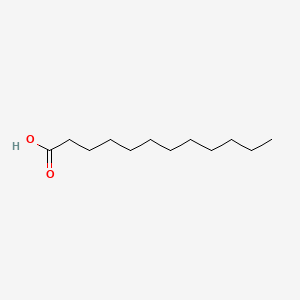
|
lauric acid |
lauric acid is a lipid of Fatty Acyls (FA) class. Lauric acid is associated with abnormalities such as Infection, Renal tubular disorder, Hypertensive disease, Obesity and Mycoses. The involved functions are known as Transcription, Genetic, Signal Transduction, Mutation, metaplastic cell transformation and Anabolism. Lauric acid often locates in Skin, Plasma membrane, Cytoplasmic matrix, Body tissue and Palmar surface. The associated genes with lauric acid are Gene Family, SLC33A1 gene, Homologous Gene, Open Reading Frames and P4HTM gene. The related lipids are Fatty Acids, Oleic Acids, Palmitates, Stearates and 9,11-linoleic acid. |
3691 |

|
stearic acid |
stearic acid is a lipid of Fatty Acyls (FA) class. Stearic acid is associated with abnormalities such as Helminthiasis, Exanthema, Chronic disease, Obesity and Dyslipidemias. The involved functions are known as acyltransferase activity, Mutation, Cell division, cell fate and Fatty Acid Metabolism. Stearic acid often locates in membrane fraction, Mouse Liver, Membrane, Body tissue and Endoplasmic reticulum, membrane. The associated genes with stearic acid are Homologous Gene, ACLY gene, Transgenes, FATE1 gene and Alleles. The related lipids are Lysophospholipids, Stearic acid, Fatty Acids, cis-vaccenic acid and Phosphatidylserines. The related experimental models are Knock-out. |
5692 |

|
Arachidonic acid |
Arachidonic acid is a lipid of Fatty Acyls (FA) class. Arachidonic acid is associated with abnormalities such as Atherosclerosis, Ischemia, Hypertensive disease, Hypertension induced by pregnancy and Vascular ring of aorta. The involved functions are known as Platelet aggregation, Anabolism, Ion Transport, Signal Transduction Pathways and Signal. Arachidonic acid often locates in Extracellular, Body tissue, Protoplasm, Tissue membrane and soluble. The associated genes with Arachidonic acid are CYP2J2 gene, CYP2E1 gene, Recombinant Proteins, POR gene and P4HTM gene. The related lipids are Fatty Acids, Glycerophospholipids, Steroids, octadecadienoic acid and 9-hydroxy-10,12-octadecadienoic acid. The related experimental models are Mouse Model and Knock-out. |
22864 |
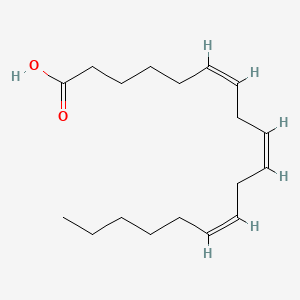
|
gamma-Linolenic acid |
Gamma-linolenic acid is a lipid of Fatty Acyls (FA) class. The involved functions are known as Drug Interactions. Gamma-linolenic acid often locates in Articular system. |
1919 |

|
alpha-linolenic acid |
Alpha-linolenic acid is a lipid of Fatty Acyls (FA) class. Alpha-linolenic acid is associated with abnormalities such as Coronary heart disease, abnormal fragmented structure, Arterial thrombosis and Subarachnoid Hemorrhage. The involved functions are known as Anabolism, Signal, Transcription, Genetic, Saturated and Regulation. Alpha-linolenic acid often locates in Blood, Body tissue, Plasma membrane, Hepatic and peroxisome. The associated genes with alpha-linolenic acid are FATE1 gene, volicitin, CYP2U1 gene, CYP1A2 gene and CYP2J2 gene. The related lipids are Fatty Acids, Dietary Fatty Acid, stearidonic acid and Fatty Acids, Nonesterified. |
4231 |

|
DHA |
Dha is a lipid of Fatty Acyls (FA) class. Dha is associated with abnormalities such as Atherosclerosis, Consumption-archaic term for TB, Chronic disease, Cardiovascular Diseases and Diabetes Mellitus, Non-Insulin-Dependent. The involved functions are known as Inflammation, Oxidation, fatty acid oxidation, Fatty Acid Metabolism and Lipid Metabolism. Dha often locates in Hepatic, Protoplasm, Mucous Membrane, Epithelium and outer membrane. The associated genes with DHA are IMPACT gene, FATE1 gene, GAPDH gene, THOC4 gene and SLC33A1 gene. The related lipids are stearidonic acid, Fatty Acids, Total cholesterol, Lipopolysaccharides and Dietary Fatty Acid. The related experimental models are Mouse Model, Transgenic Model, Animal Disease Models and Arthritis, Experimental. |
11054 |

|
7-octadecynoic acid |
7-octadecynoic acid is a lipid of Fatty Acyls (FA) class. |
8379 |
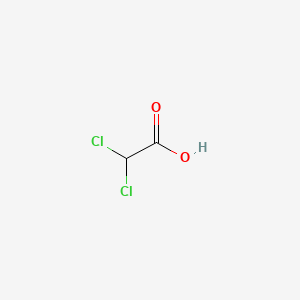
|
Dichloroacetic acid |
Dichloroacetic acid is a lipid of Fatty Acyls (FA) class. Dichloroacetic acid is associated with abnormalities such as Acidosis, Lactic, Metabolic Diseases, CLEFT LIP, CONGENITAL HEALED, Asthma and hyperthyroid. The involved functions are known as inhibitors, Chlorination, Metabolic Inhibition, Process and Sterility. Dichloroacetic acid often locates in Intestine - Large Intestine - Cecum (MMHCC), Mouse Liver, Back and Head. The associated genes with Dichloroacetic acid are GSTZ1 gene, PSMA5 gene and Maleylacetoacetate isomerase. The related lipids are Nonesterified Fatty Acids. |
2361 |
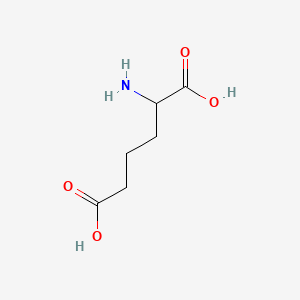
|
Aminoadipic acid |
Aminoadipic acid is a lipid of Fatty Acyls (FA) class. Aminoadipic acid is associated with abnormalities such as Diabetes and Proliferative retinopathy NOS. The involved functions are known as Uptake, Process, lysine catabolism, Pressure- physical agent and Proteolysis. Aminoadipic acid often locates in Protoplasm, Chromosomes, Astrocytic, Basal lamina and Cytoplasmic matrix. The associated genes with Aminoadipic acid are Homologous Gene, Excitatory Amino Acids, allysine, Diaminopimelic Acid and Gene Clusters. |
1114 |

|
Prostaglandin E2 |
Prostaglandin E2 is a lipid of Fatty Acyls (FA) class. Prostaglandin e2 is associated with abnormalities such as Renal glomerular disease, Arthritis, Degenerative polyarthritis, Pancreatitis and Rheumatoid Arthritis. The involved functions are known as enzyme pathway, Atherogenesis, Anabolism, inhibitors and Oxidants. Prostaglandin e2 often locates in Tissue membrane, Blood, Extracellular, Membrane and Protoplasm. The associated genes with Prostaglandin E2 are PTGS2 gene, TP53 gene, TNFRSF5 gene, FASTK Gene and TNF gene. The related lipids are Lipopolysaccharides, Steroids, monooxyethylene trimethylolpropane tristearate, Fatty Acids, Unsaturated and Promega. The related experimental models are Arthritis, Adjuvant-Induced, Xenograft Model, Experimental Autoimmune Encephalomyelitis, Cancer Model and Knock-out. |
49278 |

|
PGD2 |
Pgd2 is a lipid of Fatty Acyls (FA) class. Pgd2 is associated with abnormalities such as Inflammatory disorder, Pleurisy, Rhinitis, Dehydration and Pneumonia. The involved functions are known as antagonists, fat cell differentiation, Phosphorylation, Process and Gene Expression. Pgd2 often locates in Cell surface, Body tissue, Extracellular, Bone Marrow and Membrane. The associated genes with PGD2 are oxytocin, 1-desamino-(O-Et-Tyr)(2)-, P4HTM gene, PTGS2 gene, PTGDS gene and IL3 gene. The related lipids are 15-deoxyprostaglandin J2, Nonesterified Fatty Acids, Lipopolysaccharides, Steroids and Liposomes. The related experimental models are Knock-out and Rodent Model. |
6464 |

|
11beta-PGF2 |
11beta-pgf2 is a lipid of Fatty Acyls (FA) class. |
15009 |
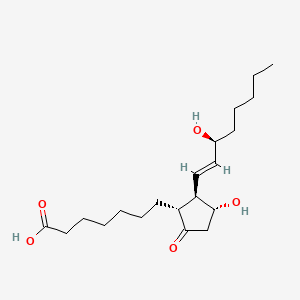
|
Prostaglandin e1 |
Prostaglandin e1 is a lipid of Fatty Acyls (FA) class. The involved functions are known as Protein Expression and Down-Regulation. |
5126 |

|
Leukotriene b4 |
Leukotriene b4 is a lipid of Fatty Acyls (FA) class. The involved functions are known as Chemotaxis, release of sequestered calcium ion into cytoplasm and Polymerization. Leukotriene b4 often locates in Protoplasm. The associated genes with Leukotriene b4 are phallacidin. |
9311 |
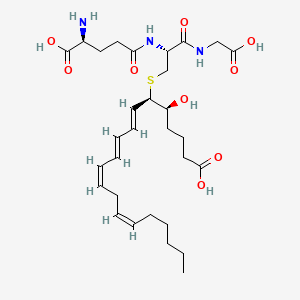
|
LTC4 |
Ltc4 is a lipid of Fatty Acyls (FA) class. Ltc4 is associated with abnormalities such as Asthma, Eosinophilia, Pulmonary Eosinophilia, Pneumonia and Cardiovascular Diseases. The involved functions are known as Signal, Gene Expression, Stimulus, Signal Transduction and Metabolic Inhibition. Ltc4 often locates in Plasma membrane, Cytoplasm, Back, Cytoplasmic and Tissue membrane. The associated genes with LTC4 are STIM1 gene, ABCC2 gene, CD9 gene, Mutant Proteins and Amino Acids, Aromatic. The related lipids are glycolithocholate. |
2252 |
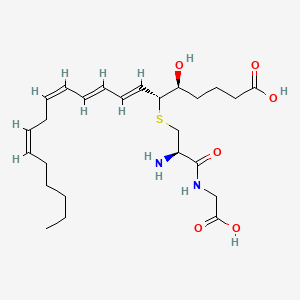
|
LTD4 |
Ltd4 is a lipid of Fatty Acyls (FA) class. Ltd4 is associated with abnormalities such as Inflammatory Bowel Diseases, Inflammatory disorder, Asthma, Pneumonia and Allergic asthma. The involved functions are known as inhibitors, Signal Transduction, Cell Survival, antagonists and Phosphorylation. Ltd4 often locates in Membrane, Tissue membrane, Protoplasm, Cytoplasmic matrix and membrane fraction. The associated genes with LTD4 are ALOX5 gene, UMOD gene, P4HTM gene, RAF1 gene and Homologous Gene. The related lipids are Lipopolysaccharides. |
1167 |
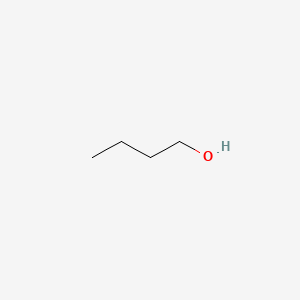
|
1-butanol |
1-butanol is a lipid of Fatty Acyls (FA) class. |
5925 |
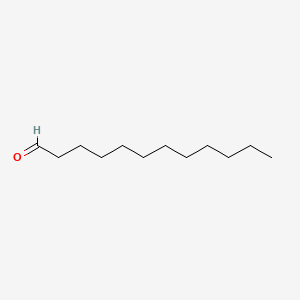
|
Dodecanal |
Dodecanal is a lipid of Fatty Acyls (FA) class. |
2130 |
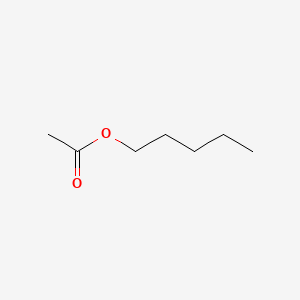
|
Amyl acetate |
Amyl acetate is a lipid of Fatty Acyls (FA) class. |
399 |

|
Anandamide |
Anandamide is a lipid of Fatty Acyls (FA) class. Anandamide is associated with abnormalities such as Dehydration. The involved functions are known as Process, Phenomenon, Phosphorylation, Catabolic Process and Gene Expression. Anandamide often locates in Nuchal region, Microglial and Hepatic. The associated genes with Anandamide are SGPL1 gene, SPTLC1 gene, RPSA gene, KDSR gene and SMPD1 gene. The related lipids are Sphingolipids, Lipopolysaccharides, Lysophospholipids, LYSO-PC and lysophosphatidylethanolamine. |
4747 |
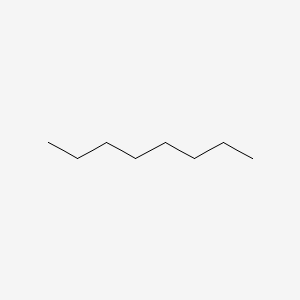
|
Octane |
Octane is a lipid of Fatty Acyls (FA) class. The involved functions are known as enzyme activity and Synthesis. Octane often locates in Mitochondrial matrix. |
2354 |

|
Hexane |
Hexane is a lipid of Fatty Acyls (FA) class. |
9183 |

|
(e,e,e,e)-squalene |
(e,e,e,e)-squalene is a lipid of Fatty Acyls (FA) class. (e,e,e,e)-squalene is associated with abnormalities such as Hypercholesterolemia and Cataract. The involved functions are known as Process, metaplastic cell transformation, Protein Overexpression, Anabolism and Biosynthetic Pathways. (e,e,e,e)-squalene often locates in Membrane, Protoplasm, Plasma membrane, Tissue membrane and Back. The associated genes with (e,e,e,e)-squalene are Genome, IMPACT gene, GAPDH gene, GTF2I gene and Chromatin. The related lipids are Membrane Lipids, cycloartenol, Sterols, Fatty Acids and Nonesterified Fatty Acids. |
1766 |

|
Platelet activating factor |
Platelet activating factor is a lipid of Glycerophospholipids (GP) class. Platelet activating factor is associated with abnormalities such as Atherosclerosis, Acute cholecystitis without calculus, Cholecystitis, Colitis and Cholecystitis, Acute. The involved functions are known as Cell Survival, Metabolic Inhibition, lipid oxidation, Apoptosis and Oxidation. Platelet activating factor often locates in soluble, Cellular Membrane, Smooth muscle (tissue), Intima and Tissue specimen. The associated genes with Platelet activating factor are apolipoprotein A-I Milano, Homologous Gene, TSPO gene, HBEGF gene and SLC33A1 gene. The related lipids are Hydroxycholesterols, Liposomes, 25-hydroxycholesterol, Lysophosphatidylcholines and Lipopolysaccharides. The related experimental models are Knock-out, Mouse Model and Transgenic Model. |
7383 |
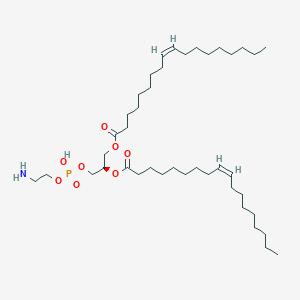
|
PE(18:1(9Z)/18:1(9Z)) |
PE(18:1(9Z)/18:1(9Z)) is a lipid of Glycerophospholipids (GP) class. Pe(18:1(9z)/18:1(9z)) is associated with abnormalities such as Respiratory Failure, Myopathy, Muscular Dystrophy, Duchenne, Autoimmune Lymphoproliferative Syndrome and Osteoporosis. The involved functions are known as establishment and maintenance of localization, Anabolism, Protein Biosynthesis, nuclear mRNA cis splicing, via spliceosome and Increased Sensitivy. Pe(18:1(9z)/18:1(9z)) often locates in Sarcolemma, Muscle, Membrane, viral nucleocapsid location and Tissue fiber. The associated genes with PE(18:1(9Z)/18:1(9Z)) are DMD gene, DUOXA1 gene, P4HTM gene, delta sleep-inducing peptide, N-Tyr- and Homologous Gene. The related lipids are Lipofectin, Liposomes, Pregnadienes, N-(1-(2,3-dioleyloxy)propyl)-N,N,N-trimethylammonium chloride and DOPE. |
1117 |

|
tacrolimus |
Tacrolimus is a lipid of Polyketides (PK) class. Tacrolimus is associated with abnormalities such as Renal glomerular disease. The involved functions are known as inhibitors, Fungicidal activity, Metabolic Inhibition, Excretory function and Dephosphorylation. Tacrolimus often locates in Hepatic, Mitochondrial matrix and Inner mitochondrial membrane. The associated genes with Tacrolimus are RHOA gene and BGN gene. |
12730 |

|
erythromycin |
erythromycin is a lipid of Polyketides (PK) class. Erythromycin is associated with abnormalities such as Systemic Inflammatory Response Syndrome, Pneumonia, Infection, Pneumococcal Infections and Exanthema. The involved functions are known as Pharmacodynamics, Sterility, Agent, Drug Kinetics and Adjudication. Erythromycin often locates in Blood, peritoneal, Extracellular, Ribosomes and apicoplast. The associated genes with erythromycin are P4HTM gene, SLC33A1 gene, FAM3B gene, Operon and Homologous Gene. The related lipids are Hydroxytestosterones, Steroids, Propionate, Mycolic Acids and campesterol. The related experimental models are Mouse Model and Knock-out. |
19871 |

|
Azithramycine |
Azithramycine is a lipid of Polyketides (PK) class. Azithramycine is associated with abnormalities such as Respiratory Tract Infections, Pneumonia, Lower respiratory tract infection, Infection and Nonspecific urethritis. The involved functions are known as Lysis, Selection, Genetic, Mutation, Relapse and Adaptation. Azithramycine often locates in Blood, Respiratory System, Genitourinary system, Back and Chest. The associated genes with Azithramycine are Genes, rRNA, Genome, RPL22 gene, OPRM1 gene and tryptic soy broth. The related lipids are Liposomes, Phosphatidylserines, Promega, Lipopolysaccharides and Steroids. The related experimental models are Mouse Model, Knock-out and Tissue Model. |
7835 |

|
minocycline |
minocycline is a lipid of Polyketides (PK) class. Minocycline is associated with abnormalities such as Infection, Soft Tissue Infections, Septicemia, Chronic hyponatremia and Lesion of brain. The involved functions are known as Pharmacodynamics, Gene Expression, Transcriptional Activation, Regulation and Process. Minocycline often locates in Ribosomes, 50S ribosomal subunit, Blood, Skin and Immune system. The associated genes with minocycline are THEMIS gene, KCNK2 gene, RBFOX3 gene, PIWIL2 gene and P4HTM gene. The related lipids are Lipopolysaccharides, Promega, Steroids, Liposomes and Octanols. The related experimental models are Mouse Model, Experimental Autoimmune Encephalomyelitis, Genetically Engineered Mouse, Disease model and spinal model. |
9780 |

|
oxytetracycline |
oxytetracycline is a lipid of Polyketides (PK) class. Oxytetracycline is associated with abnormalities such as Infection, X-linked centronuclear myopathy, Bacterial Infections, Heart failure and Onchocerciasis. The involved functions are known as Anabolism, physiological aspects, Transcription, Genetic, Fermentation and Transcriptional Activation. Oxytetracycline often locates in Chromosomes, Flank (surface region), Entire bony skeleton, Bone Marrow and Body tissue. The associated genes with oxytetracycline are Polypeptides, Homologous Gene, Gene Clusters, Locus and CYCS gene. The related lipids are LH 1 and Lipid Peroxides. The related experimental models are Disease model. |
6787 |
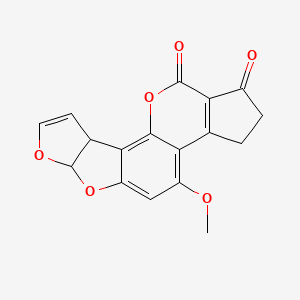
|
AFBI |
AFBI is a lipid of Polyketides (PK) class. Afbi is associated with abnormalities such as Pyotraumatic dermatitis, Infection, Hepatitis, Liver diseases and Hepatitis B. The involved functions are known as Immune response, Mutation, Anabolism, Metabolic Inhibition and Increased Sensitivy. Afbi often locates in Body tissue, Hepatic, Cytoplasm, Blood and Micronucleus. The associated genes with AFBI are TP53 gene, Genome, Transgenes, FATE1 gene and MANEA gene. The related lipids are Lipopolysaccharides, Lipid Peroxides, 1-(2-cyano-3,12-dioxooleana-1,9-dien-28-oyl) imidazole and Liposomes. |
5774 |
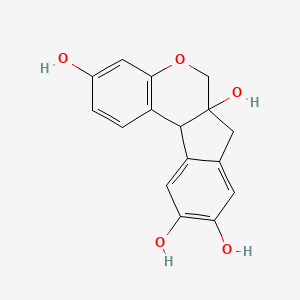
|
Brazilin |
Brazilin is a lipid of Polyketides (PK) class. |
128 |
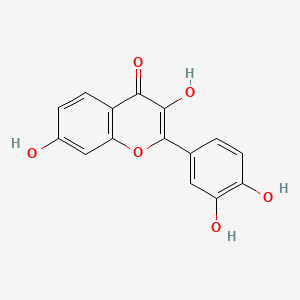
|
Fisetin |
Fisetin is a lipid of Polyketides (PK) class. Fisetin is associated with abnormalities such as Morphologically altered structure, PARKINSON DISEASE, LATE-ONSET, Tetanus, CNS disorder and Disintegration (morphologic abnormality). The involved functions are known as Autophagy, Apoptosis, Energy Metabolism, Acceleration and Anabolism. Fisetin often locates in Mitochondria, Cytoplasmic matrix, Extracellular, Cytoskeletal Filaments and Autophagic vacuole. The associated genes with Fisetin are SIRT1 gene, MAP1LC3A gene, TP53 gene, P4HTM gene and AURKB gene. The related lipids are Phosphatidylserines and Lipopolysaccharides. The related experimental models are Animal Cancer Model, Xenograft Model, Mouse Model, Cancer Model and Disease model. |
832 |
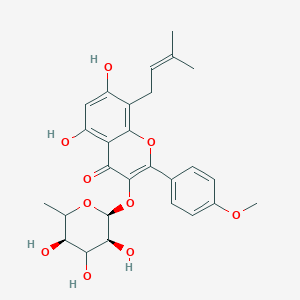
|
Baohuoside 1 |
Baohuoside 1 is a lipid of Polyketides (PK) class. |
130 |
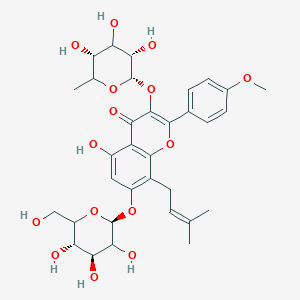
|
LMPK12112009 |
LMPK12112009 is a lipid of Polyketides (PK) class. |
216 |
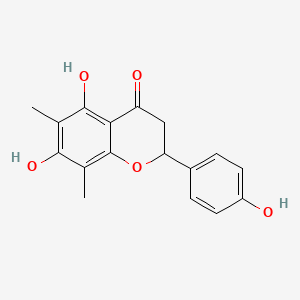
|
Farrerol |
Farrerol is a lipid of Polyketides (PK) class. The involved functions are known as Transcription, Genetic, antioxidant activity, Metabolic Inhibition, Gene Expression and Hemolysis (biological funtion). The associated genes with Farrerol are SLC33A1 gene and Locus. |
49 |

|
doxorubicin |
Adriamycin is a lipid of Polyketides (PK) class. Adriamycin is associated with abnormalities such as Cardiomyopathies. The involved functions are known as Transcription, Genetic, Process, Drug effect disorder, Diastasis and Oxidation-Reduction. Adriamycin often locates in Muscle, Myocardium and Entire gastrointestinal tract. |
54913 |
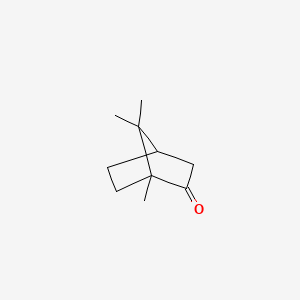
|
(+)-Camphor |
(+)-camphor is a lipid of Prenol Lipids (PR) class. (+)-camphor is associated with abnormalities such as Athetoid cerebral palsy. The involved functions are known as inhibitors, Synthesis, Feedback and Competitive inhibition. The associated genes with (+)-Camphor are 4S-limonene synthase. The related lipids are palmitoleic acid, pentadecanoic acid, stearic acid and erucic acid. |
3660 |
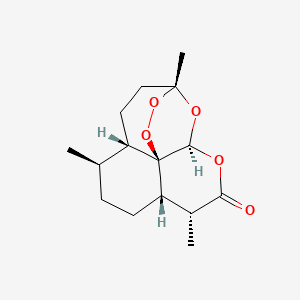
|
Artemisin |
Artemisin is a lipid of Prenol Lipids (PR) class. Artemisin is associated with abnormalities such as Malaria, Falciparum. The involved functions are known as Pressure- physical agent and secondary metabolic process. |
4738 |

|
phorbol 13-acetate 12-myristate |
Phorbol 13-acetate 12-myristate is a lipid of Prenol Lipids (PR) class. The involved functions are known as DNA Fragmentation, Phosphorylation and Irritation. Phorbol 13-acetate 12-myristate often locates in low-density lipoprotein particle. The associated genes with phorbol 13-acetate 12-myristate are FPR1 gene and ABCB1 gene. |
40921 |

|
Sphingosine 1-phosphate |
Sphingosine 1-phosphate is a lipid of Sphingolipids (SP) class. Sphingosine 1-phosphate is associated with abnormalities such as Infection, Painful Bladder Syndrome, Atherosclerosis, Hyperglycemia and Rheumatoid Arthritis. The involved functions are known as Phosphorylation, Regulation, enzyme activity, Energy Absorption and Vascular Permeability. Sphingosine 1-phosphate often locates in Endothelium, Tissue membrane, Vascular System, Protoplasm and Microfilaments. The associated genes with Sphingosine 1-phosphate are MBTPS1 gene, FBXL15 gene, TEK gene, NTRK1 gene and Gene Family. The related lipids are Promega, Lipopolysaccharides, lysophosphatidic acid, Lysophosphatidylcholines and Lysophospholipids. The related experimental models are Knock-out, Mouse Model, Transgenic Model, Disease model and Experimental Autoimmune Encephalomyelitis. |
2005 |

|
cholesterol |
cholesterol is a lipid of Sterol Lipids (ST) class. Cholesterol is associated with abnormalities such as Trypanosomiasis, Chagas Disease, Cleft Palate, Chondrodysplasia punctata 2, X-linked dominant and Child syndrome. The involved functions are known as Blood Circulation, Sterol Biosynthesis Pathway, Receptor Mediated Endocytosis, Methylation and Signal. Cholesterol often locates in Animal tissue, Blood, Membrane, Plasma membrane and peroxisome. The associated genes with cholesterol are MBD2 gene, SIM, SLC33A1 gene, Genome and NSDHL gene. The related lipids are Sterols, zymosterol, fecosterol, Total cholesterol and 7-dehydrocholesterol. The related experimental models are Mouse Model, Knock-out, Genetically Engineered Mouse and Disease model. |
98461 |










































